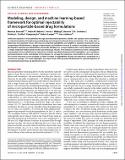Notice
This is not the latest version of this item. The latest version can be found at:https://dspace.mit.edu/handle/1721.1/135398.2
Modeling, design, and machine learning-based framework for optimal injectability of microparticle-based drug formulations
| dc.contributor.author | Sarmadi, Morteza | |
| dc.contributor.author | Behrens, Adam M | |
| dc.contributor.author | McHugh, Kevin J | |
| dc.contributor.author | Contreras, Hannah TM | |
| dc.contributor.author | Tochka, Zachary L | |
| dc.contributor.author | Lu, Xueguang | |
| dc.contributor.author | Langer, Robert | |
| dc.contributor.author | Jaklenec, Ana | |
| dc.date.accessioned | 2021-10-27T20:23:17Z | |
| dc.date.available | 2021-10-27T20:23:17Z | |
| dc.date.issued | 2020 | |
| dc.identifier.uri | https://hdl.handle.net/1721.1/135398 | |
| dc.description.abstract | Inefficient injection of microparticles through conventional hypodermic needles can impose serious challenges on clinical translation of biopharmaceutical drugs and microparticle-based drug formulations. This study aims to determine the important factors affecting microparticle injectability and establish a predictive framework using computational fluid dynamics, design of experiments, and machine learning. A numerical multiphysics model was developed to examine microparticle flow and needle blockage in a syringe-needle system. Using experimental data, a simple empirical mathematical model was introduced. Results from injection experiments were subsequently incorporated into an artificial neural network to establish a predictive framework for injectability. Last, simulations and experimental results contributed to the design of a syringe that maximizes injectability in vitro and in vivo. The custom injection system enabled a sixfold increase in injectability of large microparticles compared to a commercial syringe. This study highlights the importance of the proposed framework for optimal injection of microparticle-based drugs by parenteral routes. | |
| dc.language.iso | en | |
| dc.publisher | American Association for the Advancement of Science (AAAS) | |
| dc.relation.isversionof | 10.1126/SCIADV.ABB6594 | |
| dc.rights | Creative Commons Attribution NonCommercial License 4.0 | |
| dc.rights.uri | https://creativecommons.org/licenses/by-nc/4.0/ | |
| dc.source | Science Advances | |
| dc.title | Modeling, design, and machine learning-based framework for optimal injectability of microparticle-based drug formulations | |
| dc.type | Article | |
| dc.relation.journal | Science Advances | |
| dc.eprint.version | Final published version | |
| dc.type.uri | http://purl.org/eprint/type/JournalArticle | |
| eprint.status | http://purl.org/eprint/status/PeerReviewed | |
| dc.date.updated | 2021-06-22T15:46:16Z | |
| dspace.orderedauthors | Sarmadi, M; Behrens, AM; McHugh, KJ; Contreras, HTM; Tochka, ZL; Lu, X; Langer, R; Jaklenec, A | |
| dspace.date.submission | 2021-06-22T15:46:18Z | |
| mit.journal.volume | 6 | |
| mit.journal.issue | 28 | |
| mit.license | PUBLISHER_CC | |
| mit.metadata.status | Authority Work and Publication Information Needed |
